 W
WThe military history of Ireland comprises thousands of years of armed actions in the territory encompassing the island of Ireland.
 W
WThe Battle of Glenn Máma or Glenmama was a battle that took place, most probably near Lyons Hill in Ardclough, County Kildare in AD 999 between Windmill Hill and Blackchurch. It was the decisive and only engagement of the brief Leinster revolt of 999–1000 against the King of Munster, Brian Boru. In it, the combined forces of the Kingdoms of Munster and Meath, under King Brian Boru and the High King of Ireland, Máel Sechnaill II, inflicted a crushing defeat on the allied armies of Leinster and Dublin, led by King Máel Mórda of Leinster.
 W
WThe Battle of Benburb took place on 5 June 1646 during the Irish Confederate Wars, the Irish theatre of the Wars of the Three Kingdoms. It was fought between the Irish Confederation under Owen Roe O'Neill and a Scottish Covenanter and Anglo-Irish army under Robert Monro. The battle ended in a decisive victory for the Irish Confederates and ended Scottish hopes of conquering Ireland and imposing their own religious settlement there.
 W
WBlackrock Island is a rocky island rising to a height of 70 metres above sea level and located northwest of Achill Island approximately 12 miles west of Blacksod Bay. Typical rainfall is 72 inches per annum, and the island is often shrouded in mist. It is visible from near the Glosh Tower on the Mullet Peninsula, with reference to the other islands in the area, is sometimes described as the "one that looks like a volcano".
 W
WThe Battle of the Boyne was a battle in 1690 between the forces of the deposed King James II of England and Ireland, VII of Scotland, versus those of King William III who, with his wife Queen Mary II, had acceded to the Crowns of England and Scotland in 1689. The battle took place across the River Boyne close to the town of Drogheda in the Kingdom of Ireland, modern-day Republic of Ireland, and resulted in a victory for William. This turned the tide in James's failed attempt to regain the British crown and ultimately aided in ensuring the continued Protestant ascendancy in Ireland.
 W
WThe Battle of Callann was fought in August 1261 between the Hiberno-Normans, under John FitzGerald, and three Gaelic clans: MacCarthy, who held the Kingdom of Desmond, and their kinsmen, the O'Sullivans, and the O'Donoghues under Fínghin Mac Carthaigh, King of Desmond, ancestor of the MacCarthy Reagh dynasty. It took place in the townland of Callann or Collon near modern-day Kilgarvan, County Kerry. MacCarthaigh was victorious.
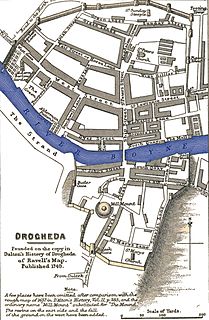 W
WThe Siege of Drogheda took place on 3–11 September 1649, at the outset of the Cromwellian conquest of Ireland. The coastal town of Drogheda was held by the Irish Catholic Confederation and English Royalists under the command of Sir Arthur Aston when it was besieged by Parliamentarian forces under Oliver Cromwell. After Aston rejected an invitation to surrender, the town was stormed and much of the garrison was executed including an unknown but "significant number" of civilians. The outcome of the siege and the extent to which civilians were targeted is a significant topic of debate among historians.
 W
WLouise Gavan Duffy was an educator, an Irish language enthusiast and a Gaelic revivalist, setting up the first Gaelscoil in Ireland. She was also a suffragist and Irish nationalist who was present in the General Post Office, the main headquarters during the 1916 Easter Rising.
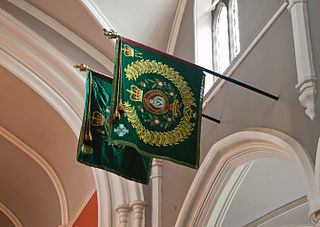 W
WFaugh a Ballagh is a battle cry of Irish origin, meaning "clear the way". The spelling is an 18th-century anglicization of the Irish language phrase Fág an Bealach [ˈfˠaːɡ ənˠ ˈbʲalˠəx], also written Fág a' Bealach. Its first recorded use as a regimental motto was by the 87th Regiment of Foot in 1798. It remains the motto of the Royal Irish Regiment today.
 W
WThe Flagstaff Hill incident was an international incident between the Republic of Ireland and the United Kingdom. It took place on the night of 5/6 May 1976 near Cornamucklagh, a townland just inside the Cooley Peninsula in the north of County Louth in the Republic of Ireland, when the Irish Army and Garda Síochána arrested eight British Special Air Service soldiers who had illegally crossed the Irish border.
 W
WGaelic warfare was the type of warfare practised by the Gaelic peoples, that is the Irish, Scottish, and Manx, in the pre-modern period.
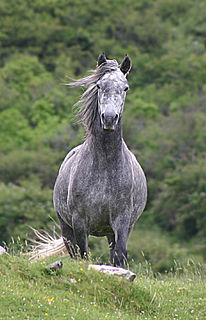 W
WHobelars were a type of light cavalry, or mounted infantry, used in Western Europe during the Middle Ages for skirmishing. They originated in 13th century Ireland, and generally rode hobbies, a type of light and agile horse.
 W
WThe Board of Ordnance in the Kingdom of Ireland performed the equivalent duties of the British Board of Ordnance: supplying arms and munitions, overseeing the Royal Irish Artillery and the Irish Engineers, and maintaining the fortifications in the island.
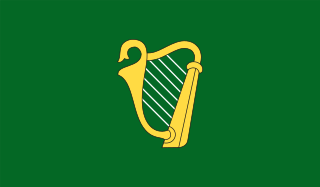 W
WTwo Irish Commandos volunteer military units of guerilla militia fought alongside the Boers against the British forces during the Second Boer War (1899–1902).
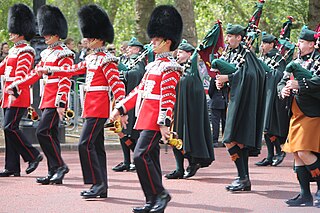 W
WThe Irish in the British Armed Forces refers to the history of Irish people serving in the British Armed Forces. Ireland was then as part of the United Kingdom from 1800-1922 and during this time in particular many Irishmen fought in the British Army. Different social classes joined the military for various reasons, including the Anglo-Irish officers who thoroughly wished to support the "mother country", while others, typically poorer Irish Catholics, did so to support their families or seeking adventure. Many Irishmen and members of the Irish diaspora in Britain and also Ulster-Scots served in both World War I and World War II as part of the British forces. However, especially since the advent of Irish independence and The Troubles, the topic of enlistment in the British forces has been controversial for the Irish at home, but does still occur. Since partition, Irish citizens have continued to have the right to serve in the British Army. Since 2007, when troops finally withdrew from the streets of Northern Ireland, the number of Irish citizens joining has increased, reaching its highest levels since World War II.
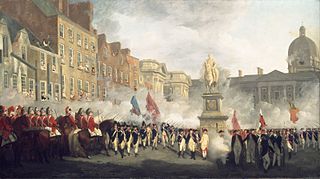 W
WThe Volunteers were local militias raised by local initiative in Ireland in 1778. Their original purpose was to guard against invasion and to preserve law and order at a time when British soldiers were withdrawn from Ireland to fight abroad during the American Revolutionary War and the government failed to organise its own militia. Taking advantage of Britain's preoccupation with its rebelling American colonies, the Volunteers were able to pressure Westminster into conceding legislative independence to the Dublin parliament. Members of the Belfast 1st Volunteer Company laid the foundations for the establishment of the United Irishmen organisation. The majority of Volunteer members however were inclined towards the yeomanry, which fought and helped defeat the United Irishmen in the Irish rebellion of 1798.
 W
WThe Battle of Julianstown was fought on 29 November 1641 at Julianstown in Ireland during the Irish Rebellion of 1641 when an English Royalist relief force was soundly defeated by Irish rebels.
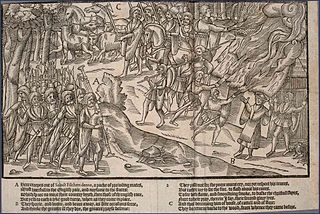 W
WA Kern was a Gaelic warrior, specifically a light infantryman, in Ireland in the late Middle Ages.
 W
WThomas FitzGerald, 10th Earl of Kildare, also known as Silken Thomas, was a leading figure in 16th-century Irish history.
 W
WThe Battle of Liscarroll was fought in County Cork on 3 September 1642, at the start of the Eleven Years' War. An Irish Confederate army approximately 8,500 strong commanded by Garret Barry, a professional soldier, was defeated by an English force commanded by a Protestant Irishman, Earl of Inchiquin.
 W
WThe Anglo-Norman invasion of Ireland took place during the late 12th century, when Anglo-Normans gradually conquered and acquired large swathes of land from the Irish, which the kingdom of England then claimed sovereignty over. At the time, Gaelic Ireland was made up of several kingdoms, with a High King claiming lordship over most of the other kings. The Norman invasion was a watershed in Ireland's history, marking the beginning of more than 800 years of direct English and, later, British involvement in Ireland.
 W
WThe Battle of Rathmines was fought on 2 August 1649, near the modern Dublin suburb of Rathmines, during the Irish Confederate Wars, an associated conflict of the 1638 to 1651 Wars of the Three Kingdoms. It has been described as the 'decisive battle of the Engagement in Ireland.'
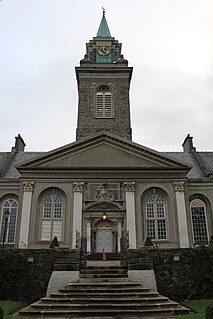 W
WThe Royal Hospital Kilmainham in Kilmainham, Dublin, is a former 17th-century hospital at Kilmainham in Ireland.
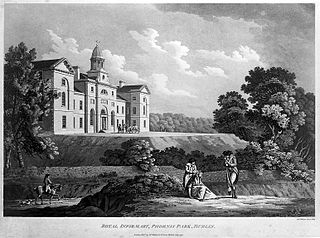 W
WThe Royal Military Infirmary (RMI) in Dublin was located at the southeastern edge of Phoenix Park, one of several former British military installations in the area. The hospital buildings are now part of the Irish Department of Defence's estate and currently houses Ireland's Office of the Director of Public Prosecutions. The bulk of the British Army's medical services in Dublin were transferred from the RMI to a new hospital at Arbour Hill in Dublin in 1913. The Infirmary buildings are protected as they are nationally significant architecture.
 W
WThe Battle of Scarrifholis was fought near Newmills, County Donegal, in northwestern Ireland on 21 June 1650, during the Irish Confederate Wars. An English Parliamentarian army commanded by Charles Coote, and composed of troops from the New Model Army and local Ulster Protestant settlers defeated the Confederate Ulster Army, commanded by Heber MacMahon, Roman Catholic Bishop of Clogher. The Ulster army lost of most of its men, officers, weapons, and supplies. The battle secured the north of Ireland for the English Parliament and contributed greatly to Cromwell's conquest of Ireland.
 W
WThe Siege of Drogheda took place from 21 November 1641 to February 1642 during the Irish Rebellion of 1641. A Catholic force under Féilim Ó Néill laid siege to the town but failed to wrest the garrison from the Royalists. During the siege, the Irish rebels made three attempts to break into and capture the town. All three attempts failed and the town was ultimately relieved by English forces.
 W
WThe Siege of Duncannon took place in 1645, during the Irish Confederate Wars. An Irish Catholic Confederate army under Thomas Preston besieged and successfully took the town of Duncannon in County Wexford from an English Parliamentarian garrison. The siege was the first conflict in Ireland in which mortars were utilized.
 W
WThe Siege of Kilkenny was the isolation and capture of the fortified capital of the Irish Confederates by the New Model Army of the English Parliamentarians in March 1650 during the conquest of Ireland by Oliver Cromwell.
 W
WLimerick, in western Ireland was the scene of two sieges during the Irish Confederate Wars. The second and largest of these took place during the Cromwellian conquest of Ireland in 1650–51. Limerick was one of the last fortified cities held by an alliance of Irish Irish Confederates and Royalists against the forces of the English Parliament. Its garrison, led by Hugh Dubh O'Neill, surrendered to Henry Ireton after a protracted and bitter siege. Over 2,000 soldiers of Cromwell's New Model Army were killed at Limerick, and Henry Ireton, Cromwell's son-in-law, died of plague.
 W
WThe Spanish Civil War lasted from July 17, 1936 to April 1, 1939. While both sides in the Spanish Civil War attracted participants from Ireland, the majority sided with the Nationalist faction.
 W
WThe Sack of Wexford took place from 2 to 11 October 1649, during the campaign known as the Cromwellian conquest of Ireland. It was part of the wider 1641 to 1653 Irish Confederate Wars, and an associated conflict of the Wars of the Three Kingdoms.